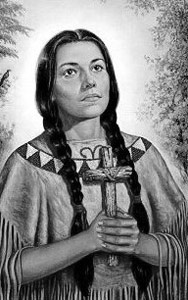Notes From Day Seven: Kateri Tekakwitha and other Native people who love the Catholic Church
 CREDIT: SSVMUSA.ORG
CREDIT: SSVMUSA.ORGKateri Tekakwitha will be canonized on October 21.
Back in the summer of 2010, First Nations people from all over Canada converged on Halifax, Nova Scotia for a pow-wow to celebrate the Christian baptism of Henri Membertou. Membertou was the Grand Chief of the Mi'kmaw people in the early days of white settlement on Canada's East Coast. His baptism in 1610 opened the way for most of the Mi'kmaw in what is now the Annapolis region to convert to Christianity and be baptised by French Catholic missionaries according to the Membertou400 website.
The website goes on to explain that these baptisms signified the emerging trust between the Mi'kmaw and the French. Perhaps this is not entirely accurate as it seems to short-change the religious significance of baptism. It may be that modern commentators are projecting their own biases when they obscure the religious dimensions of the baptisms and impose a more secular interpretation on them, an interpretation that focuses more on the political and social. (Misappropriation of religious history by moderns is not uncommon around the planet. I once visited the Tretyakov Art Gallery in Moscow and had to sit through a Marxist interpretation of an icon titled the Holy Trinity. Featuring three holy figures seated around a table, the painting was, we were told, a representation of community that found fulfillment in Communist social and political life. Who would have guessed?)
I attended the Membertou 400 pow-wow that summer of 2010. It struck me that this event did not play into the tensions that many assume dominate relations between Catholic and Native communities. After all, wasn't it Catholics who ran most of the residential schools that perpetrated abuses on Native kids and families from coast to coast? Yet, at the pow-wow, representatives of the church were front and centre with Native leaders. Veteran Cree songster Buffy Sainte- Marie spoke about the trust that existed between her grandfather's community and the local Catholic priest.
Later on I attended a hearing of the Canadian Truth and Reconciliation Commission. Some months ago it stopped at the Milbrook Native Reserve to hear from family members of the survivors of the nearby (closed) residential school. While there were expressions of anger towards the government and the churches for what the schools did to Native families, there were also gestures of reconciliation. The hearing featured Native drum circles; painful stories from Native participants were heard and recognized; some Native participants offered words of encouragement for all members of Canadian society to move forward with compassion.
On October 21, Pope Benedict will canonize Kateri Tekakwitha. That day is the 300th anniversary of her death. Tekakwitha, a Mohawk, while a teenager and young woman was intensely devoted to the Catholic faith. She died of smallpox at the age of 24. It was said that scars on her face disappeared after she died. Later, miracles were attributed to her. According to the CBC's online news, Tekakwitha is credited for saving a boy from flesh-eating disease. More recently some Natives have said that Tekakwitha gave them the strength to endure the residential school experience.
So, from now on it will be "Saint Kateri." Native communities on both sides of the Canada-U.S. boarder are claiming her for themselves, not only because, apparently, they admire her and her new prestige, but also because she lived in both what are now New York State and the Province of Quebec.
Such boundaries were of no relevance to the new saint because they did not exist. So, it is nicely fitting that she is becoming known as the first North American Native to be declared a saint by the Catholic Church. And that is another piece of the surprising and hopeful relationship that appears to be emerging between the Catholic and First Nations communities.
Editorial opinions or comments expressed in this online edition of Interrobang newspaper reflect the views of the writer and are not those of the Interrobang or the Fanshawe Student Union. The Interrobang is published weekly by the Fanshawe Student Union at 1001 Fanshawe College Blvd., P.O. Box 7005, London, Ontario, N5Y 5R6 and distributed through the Fanshawe College community. Letters to the editor are welcome. All letters are subject to editing and should be emailed. All letters must be accompanied by contact information. Letters can also be submitted online by clicking here.













